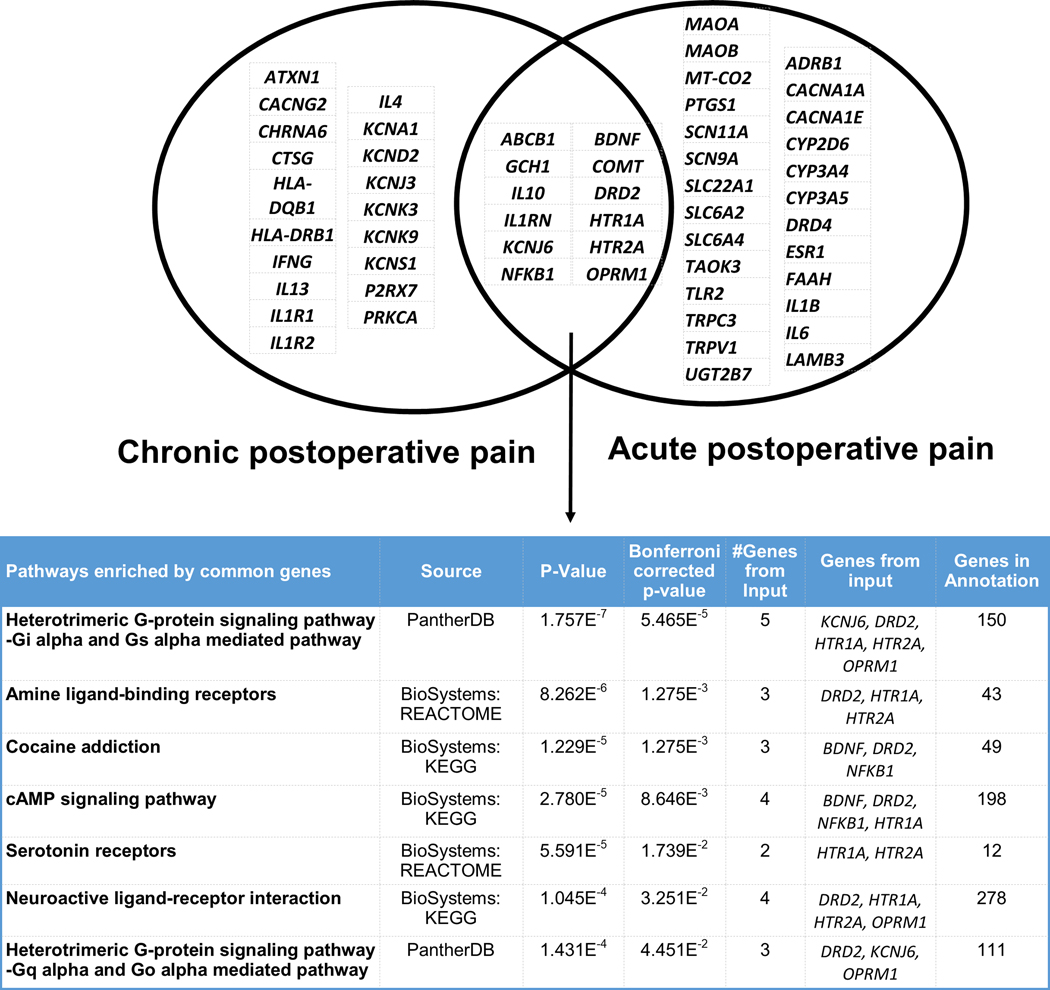Figure 1:

Venn diagram of literature-curated training genes and enriched pathways associated with acute postoperative pain (PoP) and chronic postoperative pain (CPSP) phenotypes. Upper panel shows the manually curated training gene lists, and the lower panel shows the top enriched pathways. Among the genes included solely in PoP, several had functions influencing drug metabolism (UGT2B7, MAOB, CYP3A4, CYP3A5, CYP2D6), inflammation (IL1B, IL6), ion channels (SCN11A, SCN9A, CACNA1A etc.). Other cytokine gene (IL-10/IL-1R) variants were associated with both acute and CPSP, while IL12, IL1 and IL17 variants were involved in CPSP only. There were 12 genes associated with both phenotypes. Common training genes were overrepresented in G-protein signaling, cAMP signaling, neuroactive ligand interaction and serotoninergic pathways (unadjusted p-value and Bonferroni adjusted p values for enrichment are provided). Gene symbol abbreviations: ABCB1 (ATP binding cassette subfamily B member 1), ADRB1 (adrenoceptor beta 1), BDNF (brain derived neurotrophic factor), CACNA1A (calcium voltage-gated channel subunit alpha1 A), CACNA1E (calcium voltage-gated channel subunit alpha1 E), COMT (catechol-O-methyltransferase), CYP2D6 (cytochrome P450 family 2 subfamily D member 6), CYP3A4 (cytochrome P450 family 3 subfamily A member 4), CYP3A5 (cytochrome P450 family 3 subfamily A member 5), DRD2 (dopamine receptor D2), DRD4 (dopamine receptor D4), ESR1 (estrogen receptor 1), FAAH (fatty acid amide hydrolase), GCH1 (GTP cyclohydrolase 1), HTR1A (5-hydroxytryptamine receptor 1A), HTR2A (5-hydroxytryptamine receptor 2A), IL10 (interleukin 10), IL1B (interleukin 1 beta), IL1RN (interleukin 1 receptor antagonist), IL6 (interleukin 6), KCNJ6 (potassium inwardly rectifying channel subfamily J member 6), LAMB3 (laminin subunit beta 3), MAOA (monoamine oxidase A), MAOB (monoamine oxidase B), MT-CO2 (cytochrome c oxidase subunit II), NFKB1 (nuclear factor kappa B subunit 1), OPRM1 (opioid receptor mu 1), PTGS1 (prostaglandin-endoperoxide synthase 1), SCN11A (sodium voltage-gated channel alpha subunit 11), SCN9A (sodium voltage-gated channel alpha subunit 9), SLC22A1 (solute carrier family 22 member 1), SLC6A2 (solute carrier family 6 member 2), SLC6A4 (solute carrier family 6 member 4), TAOK3 (TAO kinase 3), TLR2 (toll like receptor 2), TRPC3 (transient receptor potential cation channel subfamily C member 3), TRPV1 (transient receptor potential cation channel subfamily V member 1), UGT2B7 (UDP glucuronosyl transferase family 2 member B7); ATXN1 (ataxin 1); CACNG2 (calcium voltage-gated channel auxiliary subunit gamma 2); CHRNA6 (cholinergic receptor nicotinic alpha 6 subunit); CTSG (cathepsin G); HLA-DQB1 (major histocompatibility complex, class II, DQ beta 1); HLA-DRB1 (major histocompatibility complex, class II, DR beta 1); IFNG (interferon gamma); IL13 (interleukin 13); IL1R1 (interleukin 1 receptor type 1); IL1R2 (interleukin 1 receptor type 2); IL4 (interleukin 4); KCNA1 (potassium voltage-gated channel subfamily A member 1); KCND2 (potassium voltage-gated channel subfamily D member 2); KCNJ3 (potassium inwardly rectifying channel subfamily J member 3); KCNK3 (potassium two pore domain channel subfamily K member 3); KCNK9 (potassium two pore domain channel subfamily K member 9); KCNS1 (potassium voltage-gated channel modifier subfamily S member 1); P2RX7 (purinergic receptor P2X 7); PRKCA (protein kinase C alpha)
